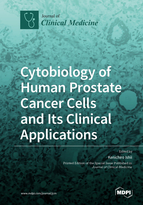Cytobiology of Human Prostate Cancer Cells and Its Clinical Applications
A special issue of Journal of Clinical Medicine (ISSN 2077-0383). This special issue belongs to the section "Oncology".
Deadline for manuscript submissions: closed (30 April 2019) | Viewed by 62690
Special Issue Editor
Interests: tumor microenvironment; prostate cancer; pancreatic cancer; stromal paracrine signals; cancer-associated fibroblasts (CAFs); drug repositioning
Special Issues, Collections and Topics in MDPI journals
Special Issue Information
Dear Colleagues,
The number of males diagnosed with prostate cancer is increasing all over the world. Most patients with early-stage prostate cancer can be treated by an appropriate therapy, such as radical prostatectomy or irradiation. On the other hand, androgen deprivation therapy (ADT) is the standard systemic therapy given to patients with advanced prostate cancer. ADT induces temporary remission, but the majority of patients (approximately 60%) eventually progress to castration-resistant prostate cancer (CRPC), which is associated with a high mortality rate.
Generally, well-differentiated prostate cancer cells are androgen-dependent, i.e., androgen receptor (AR) signalling regulates cell cycle and differentiation. Loss of AR signalling after ADT triggers androgen-independent outgrowth, generating poorly differentiated, uncontrollable prostate cancer cells. Once prostate cancer cells lose their sensitivity to ADT, effective therapies are limited. In the last few years, however, several new options for the treatment of CRPC have been approved, e.g., the CYP17 inhibitor, the AR antagonist, and the taxane. Despite this progress in development of new drugs, there is a high medical need for optimizing the sequence and combination of approved drugs. Thus, identification of predictive biomarkers may help in the context of personalized medicine to guide treatment decisions, improve clinical outcomes, and prevent unnecessary side effects.
In this Special Issue, we will focus on the cytobiology of human prostate cancer cells and its clinical applications to develop a major step towards personalized medicine matched to the individual needs of patients with early-stage and advanced prostate cancer, and CRPC.
Dr. Kenichiro Ishii
Guest Editor
Manuscript Submission Information
Manuscripts should be submitted online at www.mdpi.com by registering and logging in to this website. Once you are registered, click here to go to the submission form. Manuscripts can be submitted until the deadline. All submissions that pass pre-check are peer-reviewed. Accepted papers will be published continuously in the journal (as soon as accepted) and will be listed together on the special issue website. Research articles, review articles as well as short communications are invited. For planned papers, a title and short abstract (about 100 words) can be sent to the Editorial Office for announcement on this website.
Submitted manuscripts should not have been published previously, nor be under consideration for publication elsewhere (except conference proceedings papers). All manuscripts are thoroughly refereed through a single-blind peer-review process. A guide for authors and other relevant information for submission of manuscripts is available on the Instructions for Authors page. Journal of Clinical Medicine is an international peer-reviewed open access semimonthly journal published by MDPI.
Please visit the Instructions for Authors page before submitting a manuscript. The Article Processing Charge (APC) for publication in this open access journal is 2600 CHF (Swiss Francs). Submitted papers should be well formatted and use good English. Authors may use MDPI's English editing service prior to publication or during author revisions.
Keywords
- Prostate cancer
- Cytobiology of cancer cells
- Androgen receptor signaling
- Castration-resistant prostate cancer (CRPC)
- Predictive biomarkers
- Personalized medicine







